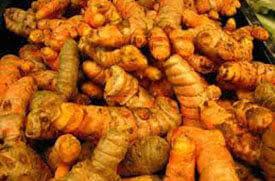BOTANICAL NAME: Curcuma aromatica
FAMILY: Zingiberaceae
ENGLISH NAME: Wild Turmeric
COMMON NAME:
Tamil- Kasturi manjal

REFERENCE: BHAVAPRAKASH SAMHITA with link e Nighantu:
https://niimh.nic.in/ebooks/e-Nighantu/bhavaprakashanighantu/?mod=read
अरण्यहलदीकन्दः कुष्ठवातास्रनाशनः |१७५|
HABITAT: Wild turmeric is found abundantly in Karnataka, Kerala, Bengal, Maharashtra.
AYURVEDIC CHARACTERISTICS:
| RASA | GUNA | VEERYA | VIPAKA | PRABHAVA | DOSHGHNTA |
| Katu, Tikta | Ruksa | Usna | Katu | Krimighna | Tridosha shamaka |
AYURVEDIC ENERGETICS:
| TASTE | PROPERTY | POTENCY | POST DIGESTIVE EFFECT | EFFECT ACTION | DOSHA ACTION |
| Pungent, Bitter. | Dry | Hot | Pungent | Worm infection | Tridosha pacifying |
MAJOR CHEMICAL CONSTITUENTS: Essential oil and curcumin.
THERAPEUTIC USES:
1 Headache:
Manjal on forehead for headache: Rhizomes are collected and fine paste is made along with lemon juice. It is applied to the forehead to relieve headache. It can be washed off after half an hour.
2 Itching skin lesions, urticaria:
Wild turmeric rhizome is rubbed well with the fresh juice of the leaves of holy basil (Tulasi) and applied over the burning and itching skin lesions caused due to insect bite. In urticaria rashes, it is of utmost use.
3 Fever, cough:
Dried wild turmeric is made into fine powder and used in the dose of 1-2 gram along with a teaspoon of honey. It pacifies the upper respiratory tract infection and viral fever.
4 Rhinitis, tonsillitis:
Fumigation carried with the wild turmeric powder acts as decongestant and expectorant. Hence useful in rhinitis and tonsillitis.
5 Lymphadenitis:
Fine paste of turmeric (along with calcified lime) is applied beneath the axilla or groin. It reduces the pain and swelling caused in cases of lymph node enlargement.
INDICATIONS:
Pandu anaemia, prameha diabetes, vrana wound healing, visavikara poisonous, kustha leprosy, tvagroga skin diseases, sitapitta urticaria.
USEFUL PART: Rhizome
DOSAGE: 1-3 g of the drug in powder form.
